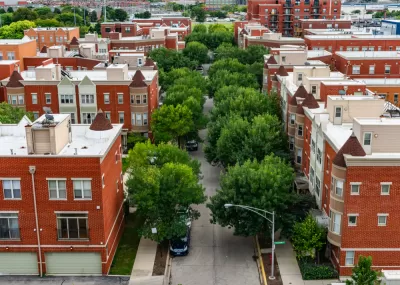Decades of building housing on the fringes of metropolitan areas have mired the United States in a housing affordability crisis defined by a widening gap between the haves and the have nots.

House-building remains a "solid idea" as the cornerstone of rebuilding the economy, according to a recent article by Matthew Yglesias, despite the history of racist exclusion with the "crabgrass frontier" approach to economic growth that defined the United States in the decades following World War II.
"A combination of rental assistance for consumers, capital funding for affordable housing, and regulatory relief for builders of all kinds could unleash a massive boom in new construction, creating countless blue-collar jobs and laying the foundation for a new era of inclusive prosperity," writes Yglesias.
This pro-development agenda for the housing market will require the United States to "direct money to those in need and [to] provide regulatory relief to those inclined to build." According to Yglesias, the success of the pro-development approach is also dependent on a shift of focus. "A big difference between the housing problems of today and those of two generations ago is where the demand is. Sprawling construction of new homes continues to take place on the crabgrass frontier, but in most cities of any size, that frontier is now located far from the most convenient commuting routes," writes Yglesias.
As a foundation for this argument, Yglesias cites numerous sources of data to show how under-housed the country is after decades of not building enough to keep up with demand. Even the news about a building boom during the George W. Bush administration, just prior to the real estate crash of the Great Recession, is oversold, according to research cited by Yglesias.
For more reading on the kinds of land use policies that have contributed to the lack of housing supply in the United States, see also a recent article by Anthony Flint, which provides a history of land use policy dating back to the end of the Civil War in making the case for a new approach. "Zoning, codes, and land-use regulations are dictating the composition of communities everywhere, and further scrutiny of all those rules would be another good step towards expanded housing options for all," writes Flint.
FULL STORY: Building housing — lots of it — will lay the foundation for a new future

Maui's Vacation Rental Debate Turns Ugly
Verbal attacks, misinformation campaigns and fistfights plague a high-stakes debate to convert thousands of vacation rentals into long-term housing.

Planetizen Federal Action Tracker
A weekly monitor of how Trump’s orders and actions are impacting planners and planning in America.

In Urban Planning, AI Prompting Could be the New Design Thinking
Creativity has long been key to great urban design. What if we see AI as our new creative partner?

How Trump's HUD Budget Proposal Would Harm Homelessness Response
Experts say the change to the HUD budget would make it more difficult to identify people who are homeless and connect them with services, and to prevent homelessness.

The Vast Potential of the Right-of-Way
One writer argues that the space between two building faces is the most important element of the built environment.

Florida Seniors Face Rising Homelessness Risk
High housing costs are pushing more seniors, many of them on a fixed income, into homelessness.
Urban Design for Planners 1: Software Tools
This six-course series explores essential urban design concepts using open source software and equips planners with the tools they need to participate fully in the urban design process.
Planning for Universal Design
Learn the tools for implementing Universal Design in planning regulations.
Gallatin County Department of Planning & Community Development
Heyer Gruel & Associates PA
JM Goldson LLC
City of Camden Redevelopment Agency
City of Astoria
Transportation Research & Education Center (TREC) at Portland State University
Jefferson Parish Government
Camden Redevelopment Agency
City of Claremont





























